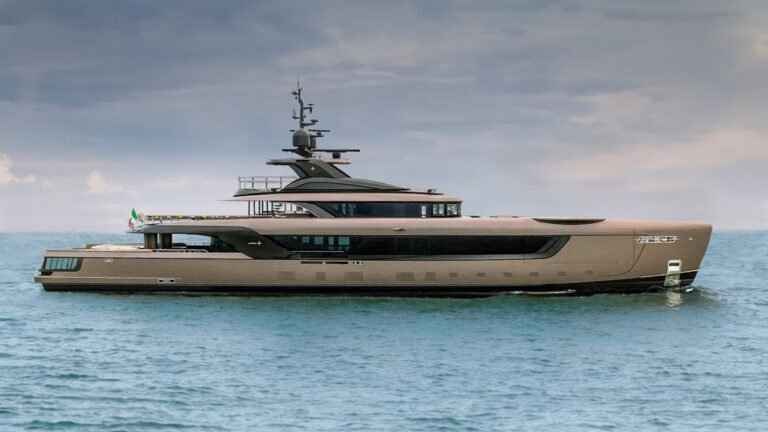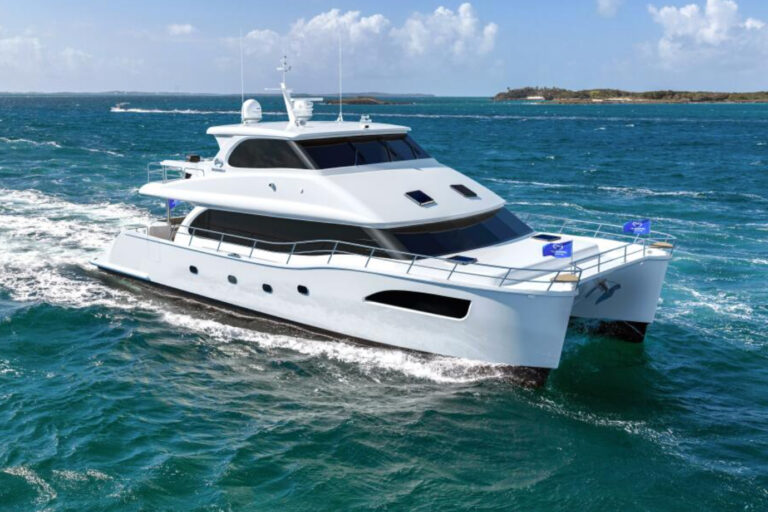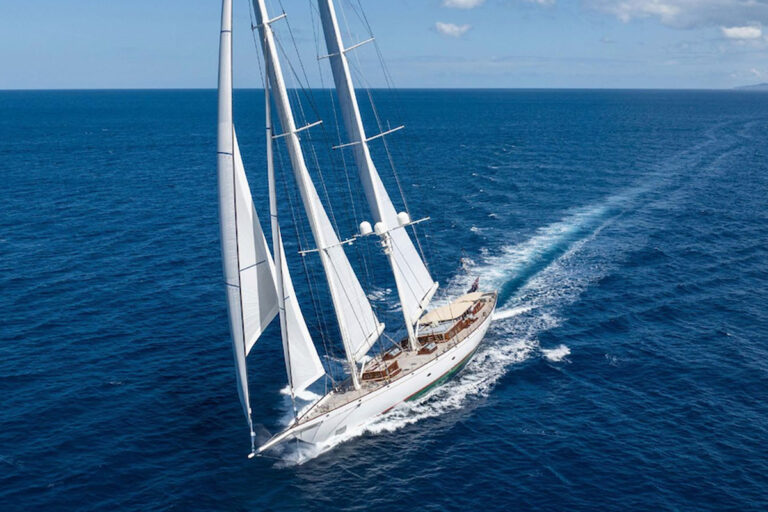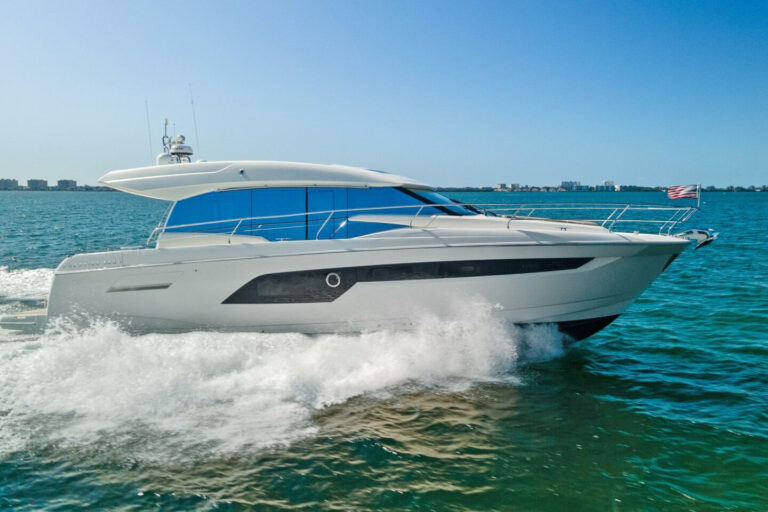For more than 75 years, Hinckley Yachts has been a benchmark in the luxury yacht market, akin to Rolls-Royce in the automobile industry and Louis Vuitton in luggage. At first, each Hinckley was carefully handcrafted from wood. As the company entered the fiberglass era, it preserved its tradition by creating fully customized yachts within the constraints of composite hulls.
In 1994, when Hinckley introduced its Bruce King-designed, 36-foot Picnic Boat, which used water jet propulsion, it raised many eyebrows. The idea proved successful, though, and sired a King-designed fleet of larger and smaller Hinckleys, all built for exploring the unexplored with jet propulsion and shallow drafts.
The company delivered the Talaria 44 Jet in 1999, and in response to customer requests, introduced the Talaria 44 Flybridge this year. Our test boat was the third version of the flying bridge model.
Beginning with the T44 Motor Yacht, Hinckley stretched the pilothouse by 15 inches, giving the flying-bridge version a large footprint. Since the company uses a patented SCRIMP resin-infusion process and a Dual-Guard skin of Kevlar, E-glass and carbon fiber, weight gain for the T44 Flybridge is a conservative 600 pounds.
If you’ve been aboard past Hinckleys, your first step into the cockpit of the Talaria 44 Flybridge is like coming home. The teak sole is inviting to even bare feet, and the syrupy varnish on the sweeping teak coamings is as flawless as the dashboard of a Rolls-Royce. These amenities are optional ($19,500), and perhaps this is the time to discuss, ahem, price.
The T44 Flybridge is not inexpensive. Our test boat, outfitted with a minimum of options, was priced at a shade over $1.3 million, putting the boat solidly at the top of the dollar-per-foot scale. It does, on the other hand, carry with it the strength of Hinckley’s tradition, quality (as well as the company’s logo on the cove stripe), and very strong resale value.
Inside the saloon, the first thing you’ll likely notice is a great view through the large windows encircling the house. Forward panes are curved, but do not distort.
The second thing you’ll notice is the gloriously finished teak-and-tulipwood sole that, again, fairly shouts that the boat is a Hinckley.
A surprising amount of fiberglass was evident in the saloon of our test boat. Though the white gelcoat was flawless, it lent a production-line quality to a yacht that should feel like a million bucks. Hinckley Vice President Joel Ewanick pointed out that our boat was a factory demonstrator with few options. On customized versions of the T44 Flybridge, all fiberglass molding can be covered with cherry to match the bulkheads. Ewanick also noted that many owners prefer fiberglass to wood for its easy maintenance, particularly in warm climates such as Florida.
I was surprised, too, by the rows of screws (all neatly aligned) visible in the cherry trim of saloon windows and in the sole. Considering the exceptional quality of Hinckley’s woodworking, I would have expected them to be plugged. Ewanick said Hinckley left screws accessible in areas that might require maintenance, to keep the wood from being destroyed during service.
The helm is nicely arranged, with enough space for an owner to flush-mount his choice of electronics. The stainless-steel, varnished-rim steering wheel is nearly horizontal, but it’s quite comfortable to use whether you’re standing or sitting. The JetStick is just where you’d want it: under your right paw. ZF shifters, tidy rows of rocker switches, and sliding windows to port and starboard complete the helm.
Our test boat had a standard cabin arrangement with the galley down and a dinette down to starboard, which can be replaced with an optional guest cabin with double berth. The optional cabin makes sense, since it allows an owner to bring aboard a guest couple for a weekend cruise without having to convert the dining table to a berth.
The galley has a two-burner Kenyon cooktop, with a microwave/convection oven below the Corian counter. The refrigerator/freezer has a top-loading freezer and an under-counter, side-loading refrigerator. Best of all, the galley provides a good view into the saloon and aft, so the cook will not feel neglected.
The forward cabin has direct access to the head compartment to port, which has a VacuFlush MSD. The shower is in a dedicated compartment to starboard with access only from the saloon, which means the owner must either tiptoe through the saloon wrapped in a towel or dress in the wet shower. Ewanick says owners may request an alternative placement for the shower.
The flying bridge is a simple fiberglass addition, with a varnished teak caprail encircling the coaming and a fiberglass helm pod with a Stidd chair. The U-shape settee is upholstered with durable fabric, and an upright mast provides a mount for radar, antennae and flags.
Power for the T44 Flybridge is a pair of 440 hp Yanmar diesels, which drive Hamilton jets through a ZF transmission. As you’d expect from Hinckley, wiring and plumbing in the engineroom is superb. An inspection point above the blades of each jet allows owners to eliminate weeds or crab-pot lines from the turbines, though the Hamiltons should easily backflush such junk. Twin wing fuel tanks feed into a central day tank via transfer pumps, and a 12kW Panda generator powers the reverse-cycle air conditioning and 110-volt appliances.
Of particular note is the soundproofing, which includes lead-lined foam (2 pounds per square foot) in the engine boxes, double gaskets on the engine covers and baffled air intakes. The result is a yacht surprisingly quiet at all speeds.
Under way, the T44 Flybridge has impeccable manners. The fine hull lines and relatively narrow beam carve easily through chop and swells, and the flared lobsterboat-style bow throws the spray out to the side rather than aft. Turns are executed without cavitation-a problem on poorly designed jet yachts-and she leaps forward with a touch of her throttle.
But it’s the JetStick that really sets this yacht apart. Computer-integrated, it forces skippers accustomed to twin-screw boat handling to forget everything they’ve ever learned. As you near the dock, simply switch to docking mode by pushing a button, which activates the JetStick and disengages the wheel. Push the joystick sideways, and the computer determines the proportion of bow thruster (a 300-pound-thrust DC unit) and jets needed to nudge the boat sideways, with speed controlled by your pressure on the JetStick.
For exploring thin-water areas, the 44 draws just 27 inches, or as Hinckley likes to say, slightly more than a champagne bottle. With no props to ding, you can beach her like a runabout.
Contact: Hinckley Yachts, (866) 446-2553; sales@hinckleyyachts.com; www.hinckleyyachts.com.









